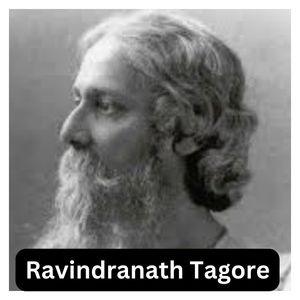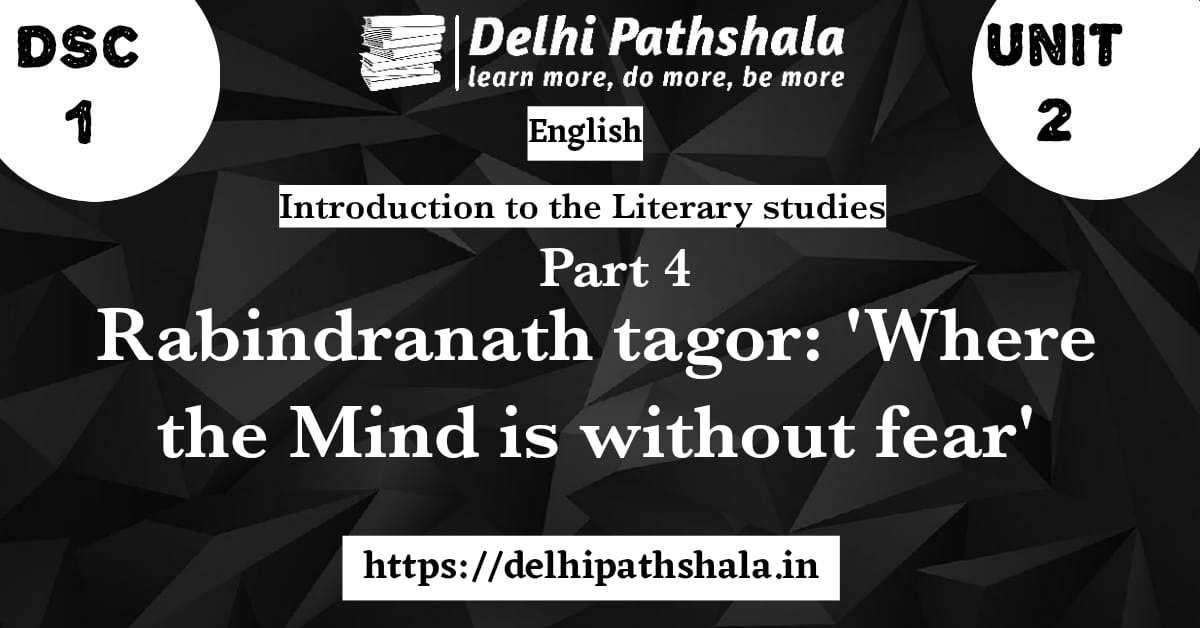English (H) DSC – 1
Introduction to Literary Studies
unit – 2 Reading Poetry, Part – 2
Rabindranath Tagore: ‘Where the Mind is Without Fear’
In this post, notes of Unit 2 (Reading Poetry – Rabindranath Tagore: ‘Where the Mind is Without Fear’) from DSC – 1 (Introduction to Literary Studies) are given which is helpful for the students doing graduation this year.
Introduction to Rabindranath Tagore and his historical context

Rabindranath Tagore (1861-1941) was a polymath, poet, philosopher, musician, and the first non-European to be awarded the Nobel Prize in Literature in 1913. Born in Calcutta (now Kolkata), India, into a prominent Bengali family, Tagore played a pivotal role in the cultural and intellectual renaissance of Bengal in the late 19th and early 20th centuries. His contributions spanned literature, music, art, education, and social reform.
Literary Contributions:
Poetry: Tagore’s poetry is considered among the finest in the world. His collections, such as “Gitanjali” (Song Offerings), reflect a deep spiritual and philosophical exploration. He often addressed themes like nature, love, and the divine.
Prose: Tagore was a prolific writer of essays, short stories, and novels. His notable works include “The Home and the World” (Ghare-Baire) and “Gora.” His writing often dealt with societal issues, the clash between tradition and modernity, and the human psyche.
Music and the Arts:
Composer: Tagore was a skilled composer and musician. He composed numerous songs (Rabindra Sangeet) that continue to be an integral part of Bengali culture. His compositions are known for their melodic richness and profound lyrics.
Painter: Tagore was an accomplished painter as well. He experimented with various art forms and was a key figure in the emergence of modern Indian art. His paintings often reflected his poetic and philosophical sensibilities.
Educational Philosophy:
Visva-Bharati: In 1901, Tagore founded the Visva-Bharati University in Santiniketan, which aimed to blend the best of Indian and Western educational philosophies. It became a center for art, culture, and intellectual exchange.
Social and Political Views:
Humanism: Tagore was a humanist who emphasized the importance of individual freedom, tolerance, and the unity of humanity. His works often conveyed a universalist message that transcended cultural and national boundaries.
Nationalism: While initially supportive of the Indian independence movement, Tagore became critical of narrow nationalism. He opposed the divisive aspects of nationalism and expressed his concerns about the potential dangers of an exclusive focus on national identity.
Historical Context:
Late 19th-early 20th Century Bengal Renaissance: Tagore emerged during the Bengal Renaissance, a period of socio-cultural and intellectual revival in Bengal. This era witnessed a resurgence of art, literature, and social reforms, with thinkers like Tagore playing a key role.
British Colonial Rule: Tagore lived during a time of British colonial rule in India. His experiences and observations of the socio-political landscape influenced his writings, and he became a voice against oppressive colonial policies.
Cultural Exchange: Tagore engaged with a global audience and participated in cultural exchanges with Western intellectuals. He traveled extensively, promoting dialogue between Eastern and Western thought.
Rabindranath Tagore’s impact extended far beyond his lifetime, and his legacy continues to influence literature, music, education, and social thought in India and around the world.
Summary and analysis of ‘Where the Mind is Without Fear’

“Where the Mind is Without Fear” is a poem by Rabindranath Tagore, which is part of his collection of poems titled “Gitanjali.” Here’s a summary and analysis of the poem:
Rabindranath Tagore Where the Mind is Without Fear sammary:
The poem envisions an idealistic world where the mind is free from fear and shackles, allowing for intellectual and spiritual growth. Tagore expresses his vision for a nation that is enlightened and progressive, unburdened by the constraints of narrow-mindedness, prejudice, and oppression.
In the poem, Tagore describes a country where people can hold their heads high with dignity and pride. He imagines a place where knowledge is not limited by traditional constraints, and where individuals can strive for truth and enlightenment without fear. The poet envisions a society where reason, truth, and awareness prevail, fostering an environment conducive to personal and collective development.
The central theme revolves around the poet’s desire for a free and fearless mind that can explore, question, and seek knowledge without hindrance. Tagore’s vision extends beyond personal freedom to encompass a collective awakening and the realization of a society that values truth, reason, and enlightenment.
Rabindranath Tagore Where the Mind is Without Fear Analysis :
Freedom and Fearlessness: The poem begins with the speaker expressing the desire for a nation “Where the mind is without fear and the head is held high.” This sets the tone for the poem, emphasizing the importance of mental freedom and the absence of fear as crucial elements for individual and national progress.
Knowledge and Enlightenment: Tagore emphasizes the value of knowledge and enlightenment throughout the poem. He envisions a world where the mind is free to explore truth, where reason is unrestrained, and where people can strive for intellectual growth without fear of persecution or oppression.
Ideals of a Progressive Nation: The poet’s vision includes a nation that is progressive, aware, and forward-thinking. He envisions a society that moves towards the light of truth and wisdom, unburdened by the darkness of ignorance and prejudice.
Call for Action: Tagore’s poem is not just a passive vision; it serves as a call to action. The poet urges the Almighty to awaken the nation to a state of fearlessness, suggesting that such a transformation requires conscious effort and a collective awakening.
Critique of Current State: Implicit in the poem is a critique of the existing societal and political conditions. Tagore envisions a better future as a contrast to the prevalent state of affairs, indicating his dissatisfaction with the restrictions on freedom and the lack of enlightenment in his contemporary society.
“Where the Mind is Without Fear” remains a powerful piece that resonates with readers for its universal themes of freedom, enlightenment, and the pursuit of knowledge. Tagore’s poetic vision continues to inspire individuals and serves as a reminder of the importance of fostering an environment that encourages intellectual growth and fearlessness.
Theme and message of ‘Where the Mind is Without Fear’
Theme of ‘Where the Mind is Without Fear’ :
The central theme of Rabindranath Tagore’s poem “Where the Mind is Without Fear” revolves around the poet’s vision for an ideal society or nation. Tagore expresses his aspirations for a world where the mind is liberated from fear and constraints, allowing for intellectual and spiritual growth. The poem touches upon various interconnected themes:
Freedom and Fearlessness: The primary theme is the pursuit of freedom and the absence of fear. Tagore envisions a society where individuals are free to think, question, and express themselves without the fear of oppression or persecution. This theme reflects the poet’s deep commitment to individual liberty and the belief that fearlessness is essential for personal and societal progress.
Intellectual Enlightenment: The poem emphasizes the importance of intellectual growth and enlightenment. Tagore’s vision is of a nation where the mind is free to explore truth and reason, unencumbered by the darkness of ignorance. The theme underscores the poet’s belief in the transformative power of knowledge and education.
Progress and Idealism: Tagore’s vision is inherently optimistic and idealistic. He envisions a nation that is progressive, forward-thinking, and moving towards a higher state of consciousness. The poem reflects a desire for positive change, envisioning a society that values truth, reason, and collective progress.
Call to the Divine: The poem incorporates a spiritual dimension, as Tagore addresses his vision to the Almighty. The act of seeking divine intervention implies a belief in a higher power that can guide the nation toward the desired state of fearlessness and enlightenment.
Message of ‘Where the Mind is Without Fear’:
The message of “Where the Mind is Without Fear” is multifaceted and resonates with universal ideals. Some key messages include:
Individual and National Liberation: The poem advocates for the liberation of the individual mind from fear and constraints. It extends this aspiration to the national level, expressing a collective desire for a nation that is free, fearless, and enlightened.
of ‘Where the Mind is Without Fear’: Tagore underscores the significance of knowledge and reason as essential tools for personal and societal advancement. He envisions a society where individuals can pursue truth and enlightenment without hindrance.
Optimism and Hope for Change: The poem carries an optimistic tone, suggesting that positive change is possible. Despite the current state of fear and limitation, Tagore’s vision is a call to action, encouraging individuals and the nation to strive for a brighter and more enlightened future.
Spiritual Connection: The inclusion of a reference to the Almighty adds a spiritual dimension to the poem. It suggests a connection between the pursuit of freedom, knowledge, and a higher, transcendent reality. The poem’s spiritual aspect emphasizes the holistic nature of Tagore’s vision.
In essence, “Where the Mind is Without Fear” serves as a poetic manifesto for a society characterized by freedom, fearlessness, intellectual enlightenment, and collective progress. Tagore’s message continues to inspire readers to aspire to higher ideals and work towards creating a world where the mind is truly without fear.
Form and structure of ‘Where the Mind is Without Fear’
The form and structure of Rabindranath Tagore’s poem “Where the Mind is Without Fear” contribute to the overall impact and effectiveness of the work. Here are the details of the form and structure:
Form of ‘Where the Mind is Without Fear’:
Free Verse: The poem is written in free verse, which means it lacks a specific rhyme scheme or meter. This form allows Tagore the flexibility to express his ideas freely without being constrained by traditional poetic structures. Free verse is often associated with a more natural and spontaneous flow of language.
Prose-Like Style: Tagore’s language in this poem is often prose-like, with sentences flowing seamlessly into each other. This style enhances the conversational and contemplative nature of the poem, making it accessible to a wide audience.
Structure of ‘Where the Mind is Without Fear’:
Stanzas: The poem is divided into a single stanza, making it a monostich or monostanzaic poem. This choice of structure contributes to the sense of unity and coherence in the poem. Despite its brevity, the poem contains powerful and impactful ideas within this single stanza.
Line Length: While the poem doesn’t adhere to a strict meter, Tagore maintains a consistent line length throughout. The lines are relatively short, contributing to the concise and focused nature of each thought expressed in the poem.
Repetition: Tagore employs repetition for emphasis, notably in the use of the phrase “Where the mind is without fear” at the beginning of each line. This repetition reinforces the central theme of the poem and adds a rhythmic quality, even in the absence of a formal rhyme scheme.
Enjambment: The poem features enjambment, where a sentence or phrase carries over from one line to the next without a pause. This technique contributes to the smooth and uninterrupted flow of the poem, allowing ideas to connect seamlessly.
Imagery and Symbolism: While not a structural element in the traditional sense, the poem’s structure is enriched by vivid imagery and symbolism. Tagore uses concise yet powerful language to paint a picture of the ideal world he envisions, making the poem emotionally resonant.
In summary, “Where the Mind is Without Fear” is characterized by its free verse form, a single-stanza structure, short lines, repetition, enjambment, and a prose-like style. Tagore’s deliberate choices in form and structure enhance the accessibility and impact of the poem, allowing the reader to engage with its powerful ideas about freedom, fearlessness, and enlightenment.
Literary devices and language of ‘Where the Mind is Without Fear’
Rabindranath Tagore’s poem “Where the Mind is Without Fear” employs various literary devices and a distinct language style to convey its profound message. Here are the details of the literary devices and language used in the poem:
Alliteration:
Examples: “mind is without fear,” “knowledge is free,” “narrow domestic walls.”
Alliteration is the repetition of consonant sounds at the beginning of adjacent or closely connected words. In this poem, it adds a rhythmic quality to the lines and emphasizes key concepts.
Repetition:
Examples: The repeated phrase “Where the mind is without fear” at the beginning of each line serves as a refrain, reinforcing the central theme and creating a rhythmic structure. This repetition is a powerful rhetorical device that underscores the poet’s vision.
Metaphor:
Example: “Into that heaven of freedom, my Father, let my country awake.”
The use of “heaven of freedom” is a metaphorical expression for the poet’s vision of an ideal, liberated society. It conveys a sense of utopia and heightened enlightenment.
Imagery:
Example: “Where the clear stream of reason has not lost its way.”
The use of imagery creates vivid mental pictures. Here, the “clear stream of reason” conjures an image of unobstructed, transparent thought, emphasizing the importance of rationality.
Symbolism:
Example: “Into that heaven of freedom.”
The term “heaven” symbolizes the ideal state of freedom and enlightenment that the poet envisions. It represents a transcendent, utopian realm that contrasts with the limitations of the present.
Parallelism:
Example: “Where the mind is led forward by thee / Into ever-widening thought and action.”
The use of parallelism involves the repetition of similar grammatical structures. It adds a rhythmic and balanced quality to the lines, reinforcing the forward movement of the mind.
Enjambment:
Example: “Where the mind is without fear and the head is held high / Where knowledge is free.”
Enjambment is the continuation of a sentence or clause without a pause beyond the end of a line. It contributes to the flowing and uninterrupted quality of the poem.
Anaphora:
Example: The repetition of the phrase “Where the mind is without fear” at the beginning of each line creates an anaphoric structure. It emphasizes the poet’s vision and anchors the reader’s attention to the central theme.
Language Style:
Tagore’s language style in this poem is characterized by simplicity, clarity, and a profound depth of thought. The language is accessible yet rich in imagery and symbolism, making the poem widely relatable while conveying complex ideas about freedom, enlightenment, and societal progress.
In conclusion, “Where the Mind is Without Fear” showcases Tagore’s mastery of literary devices such as alliteration, repetition, metaphor, imagery, symbolism, parallelism, and anaphora. These devices enhance the poetic and rhetorical impact of the poem, contributing to its enduring appeal and universal resonance.

